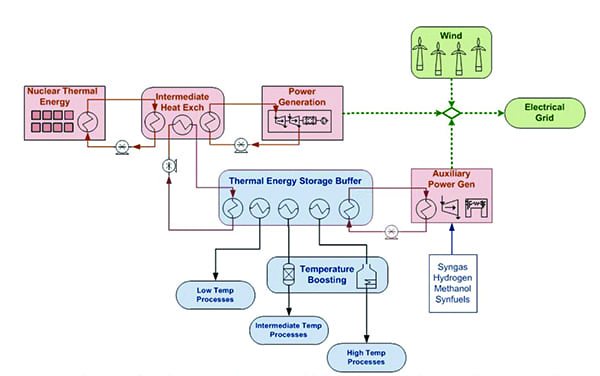 |
|
2. Researchers say “tightly coupled” nuclear-renewable hybrid energy systems (N-R HESs) are a technology opportunity that can generate dispatchable electricity while shifting uncommitted thermal or electrical energy to an energy-intensive industrial process that uses heat, steam, and/or electricity to produce fuels, chemicals, minerals, or another commodity. This schematic shows a light water N-R HES that uses wind energy, coupled with generalized industrial processes, which are classified by operational temperature. Source: “Opportunities and Challenges for Nuclear-Renewable Hybrid Energy Systems” (April 2019), National Renewable Energy Laboratory. |
However, as Mark Ruth, a researcher at the National Renewable Energy Laboratory (NREL), and a member of the Joint Institute for Strategic Energy Analysis, pointed out, while the economics of some systems are feasible, the market conditions must be right. Ruth, who studied the opportunities and challenges for “tightly coupled” N-R HESs (Figure 2) with the DOE’s Paul Spitsen and INL counterparts Richard Boardman and Shannon Bragg-Sitton, says in an April 2019-published paper that these systems may be flexible. For example, they could produce power when wholesale power prices are high, and industrial products when power prices are low. But, as in the case for HTE and LTE, success will hinge largely on hydrogen prices, power price volatility, and availability of a capacity payment.
Likewise, a Texas liquid-fuel N-R HES configuration could profitably produce power and gasoline, but only if power and gasoline prices are high. Notably, the researchers highlight that nuclear reactors could be competitive producers and marketers of thermal energy, but that prospect, they note, may require establishing a thermal-energy market that nuclear operators can access.
The Technical Case
Another significant consideration is whether the nuclear technology that exists today can be hybridized and tailored to varied applications. Dr. Thomas Jay Harrison, who heads the Reactor Safety and Licensing Team in the Advanced Reactor Engineering Group at Oak Ridge National Laboratory’s (ORNL’s) Reactor and Nuclear Systems Division, is optimistic.
Noting that the DOE’s decades-long research has yielded better materials and manufacturing knowledge, he recently told POWER: “We have such a large body of knowledge from operational experience, and we have such an advanced modeling and simulation, and mechanistic science capability to look at all those issues, that we are able to more specifically tailor a nuclear reactor or a nuclear system to meet the requirements that a user would set forth.” However, in the near-term, reactors used for hybrid applications will likely be conventional ones. “We have a lot of pressurized water reactors (PWRs) in the U.S., and it would be likely the first hybrid will use a PWR, because we do have the infrastructure and regulatory background to put that together,” he said.
Asked about the feasibility of hybridizing the existing nuclear fleet, Harrison said, “Generically speaking, all the notions that we have for nuclear power plants to be brought in for industrial purposes would be something smaller than we have typically operating in the electric fleet. Those are all too big for industrial purposes,” he said.
Developments in the micro-reactors field for military and industrial applications appear promising, he noted, however. Another benefit of multiple smaller modular reactors is their ability to fulfill power needs “in perpetuity,” which is difficult when a reactor has to be brought offline for refueling, he pointed out.
How soon the first nuclear hybrid will come online in the U.S. is less clear. At least one project is showing promise. In October 2018, ORNL, INL, and Eastman agreed to collaborate to develop a nuclear hybrid concept that could replace existing energy production infrastructure at a Kingsport, Tennessee, 150-MW combined heat and power (CHP) plant that serves the dual purpose of generating power and providing steam to run chemical processes throughout the facility.
Modeling has explored “multiple smaller units to produce steam coupled with a very simple steam distribution system,” as ORNL documents show. For Eastman, the project could signify a new business avenue. “This conceptual project will help Eastman evaluate one energy source as a potential element in our long-term energy strategy and help DOE evaluate the potential of this technology for industrial applications,” the company told POWER recently.
Nuclear Hybrid Interest Grows Worldwide
Gains in the field are also being made worldwide, specifically by countries who have both nuclear power and large industrial complexes, Harrison noted. At a meeting in Vienna hosted by the International Atomic Energy Agency (IAEA) in October 2018, 24 experts from 15 member states reviewed and discussed innovative concepts and research on the coordinated use of nuclear and renewables, as well as for non-electric (or cogeneration) applications.
As Arif Arif, a nuclear designer at the Pakistan Atomic Energy Commission, noted, his country is surveying options in nuclear desalination and reverse osmosis technology. “We want to consider nuclear–renewable hybrid energy systems by installing wind farm technology and photovoltaic cells. Our nuclear power plants are located in coastal areas, which offer good opportunities for wind farms and solar energy as well,” he said.
However, the IAEA said, citing participants at the meeting, that nuclear hybrid concepts face several hurdles. Beyond identifying the business case and the most profitable options, experts said further R&D, and possible market incentives—such as stronger carbon emission prices—were needed. “The concept of economic sustainability, development, and environmental compatibility benefits needs to be further developed and the appropriate policies must be adopted,” the IAEA said.
—Sonal Patel is a POWER senior associate editor.
Corrections (Aug. 5): Corrects titles and details about the Eastman CHP plant.
